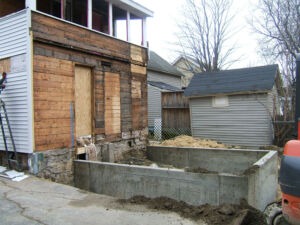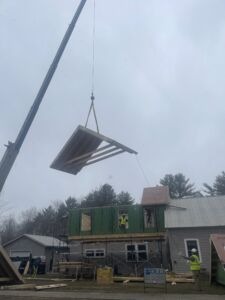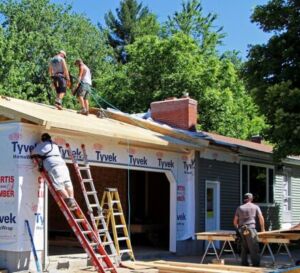![]()
So you’re looking for more space to live in but you’re not interested in moving; a home addition is the perfect choice for you. However, it can be a challenging decision to make when trying to figure out exactly what type of home addition you want. There are lots of important things to consider such as cost, home values, and location (among many other factors). Continue reading for helpful advice on choosing which type of home addition is right for you.
Brief overview of the importance of home additions
Home additions can provide homeowners with a convenient alternative to moving into a new house. Rather than enduring the painful moving process and having to give up the property that they love, an addition can be far less stressful, expensive, and time consuming! Remodeling versus moving also allows homeowners to stay in the area they’re familiar with instead of having to find a new neighborhood.
Importance of choosing the right type of addition
There are many different ways to expand your home and different reasons for each. Whether you’re looking for a conventional full-size house addition or simply adding onto an existing room, you have options. Consulting with a qualified professional will help you make a guided decision based on your preferences and needs.
POLLI Construction: a trusted partner in home remodeling in Vermont
For homeowners in Vermont, we provide thorough advice well before starting any actual construction to ensure that the plans fit exactly what our clients are looking for. We’ll evaluate the property as well as the structure and layout of the home to determine where it’d be best to build an addition. This evaluation is based on things such as efficiency, cost, and quality.
Understanding Your Needs
Before meeting with a contractor, you should have a firm understanding of what it is you need from an addition. For instance, although it isn’t technically an addition, many people choose to finish their basement as it increases their living space without changing the property’s footprint. However, depending on the circumstances of your addition, you may be looking for a project that will provide far more living space than what a simple basement remodel would give.
A. Assessing your current living situation
The first step to understanding what you need out of a home addition is assessing your current living situation. Your ultimate goal is to figure out the “why” behind your remodel so that you can more easily determine what you want.
B. Identifying your specific needs and goals for the addition
Once you’ve assessed your current property, you’ll need to solidify exactly what you need from this project and what your goals are. Are you looking to increase your overall square footage or simply increase your living space? Are you looking to build additional bedrooms, bathrooms, or something else? These are the questions you’ll need to answer for yourself.
C. Considerations for future use and resale value
Lastly, you’ll need to consider your future and whether or not this type of addition makes sense from a long-term perspective. For example, if you’re not sure that your current property is your “forever home” then it may not be a smart decision to invest into a remodel (think: moving vs. renovations). This is because the market can fluctuate and your home’s resale value may not take into account what you’ve put into it (ie. you won’t necessarily make your money back). For those who are sure of their home and simply want to make it more suitable for their needs, an addition is perfect.
Types of Home Additions
So with that in mind – which type of home addition is right for you? Let’s take a look at some popular types of home additions to help you make your decision.
Room Addition

A room addition (often referred to as a “bump-out”) is exactly what it sounds like. You’re building a single-structure room onto the side of your house typically for the purpose of adding another bedroom, bathroom, living room, or even to extend an existing room. These additions are popular for those looking for a smaller project that is less time consuming.
1. Benefits and considerations
A room addition will provide you with that additional space you need without the burden of a full-scale addition. Bump-outs can be ideal for those not looking to invest as much into their home; however, it’s important to note that they are not always a significantly cheaper option. These additions are still subject to all of the necessary protocols of any other home remodel.
2. Ideal scenarios for a room addition
An ideal room addition would be a homeowner looking to build a new singular structure or increase the size of an existing one. For instance, a room addition can be building a new bedroom or bathroom but it can also be making a tight kitchen a bit roomier or expanding a living room to be more accommodating.
3. Common rooms to consider (bedrooms, bathrooms, living rooms, etc.)
The most common rooms to consider would be bedrooms, bathrooms, living rooms, offices, dens/playrooms, or kitchens.
Second-Story Addition

For those who live in areas where land is either way too expensive or simply unavailable, second-story additions allow homeowners to greatly expand their living space without building out.
1. Pros and cons of adding a second story
Pros: Second-story additions can double your home’s finished living space, increase your property’s value, and maintain the footprint of your home as well.
Cons: These additions are a massive investment for a homeowner that will likely require the resident to temporarily move as contractors and construction workers need to work extensively in the home.
2. Factors influencing the feasibility of a second-story addition
Building up can allow for a homeowner to have a “best of both worlds” scenario where the home’s square footage can easily double while the property is untouched. Although these additions are a large investment and will require a major-albeit-temporary lifestyle change, this type of addition is very likely to pay off in the long run.
3. Considerations for structural integrity and aesthetics
Since all of the work is built on top of the existing house, it’s important to consider the longevity and structural integrity of your home. Zoning issues will also come into play so be sure to have a thorough understanding when discussing with your contractor. Lastly, consider how your home will look with a second-story addition and whether you’ll be happy with its new exterior appearance as well.
Garage Conversion
Similar to a finished basement, a garage conversion works with the structure that is already there to create a new living space for the home.
1. Transforming a garage into livable space

A garage conversion involves converting a one or two-car garage into a new room equipped with flooring, ceiling, and, of course, adding a wall to the garage doors. These additions are popular because they can be pretty versatile for a homeowner and the options are next to endless.
2. Benefits and potential challenges
While there’s a lot you can do with a garage conversion, these do come with both benefits and challenges. As for benefits, you’ll have a very customizable, relatively affordable expansion of livable space added to your home which you can use for bedrooms, bathrooms, and pretty much anything else. However, as for challenges, you’ll want to be aware of the fact that these conversions may be more difficult to make match the style of the rest of the house and will take a bit more work. Furthermore, most garages will not have plumbing or other systems (like HVAC) installed which may require additional work.
3. Creative ideas for garage conversions
If you’re thinking about a garage conversion, our suggestion is to think unique. Add a non-conventional living space to your house that wouldn’t necessarily be possible if it were an ordinary room addition.
Budget Considerations
When embarking on any home improvement project, you need to have a good idea of what type of budget you’re working with. Make sure to take a look at your finances and come up with a realistic budget that works for you. Keep in mind that there are many different factors that can influence the cost of each type of addition. Lastly, work directly with your contractor to determine the best way to maximize your available budget and avoid overspending at all costs.
Regulatory and Permitting Requirements
Vermont homeowners should look into the local regulations and building codes as well before starting any construction projects. You’ll also need to obtain any necessary permits so this is something that you’ll want to figure out in advance. A reliable contractor will be able to assist you in navigating through all of the different requirements before starting any work.
 Closing Thoughts
Closing Thoughts
Regardless of which type of home addition you choose, it’s important to go into it as informed as possible. Consider important things such as budget, longevity, time constraints, local regulations, and who is going to be doing the actual work. For Vermont homeowners, consider choosing POLLI Construction for all of your custom building and remodeling needs. We’re here to help! Contact us today for more information.
